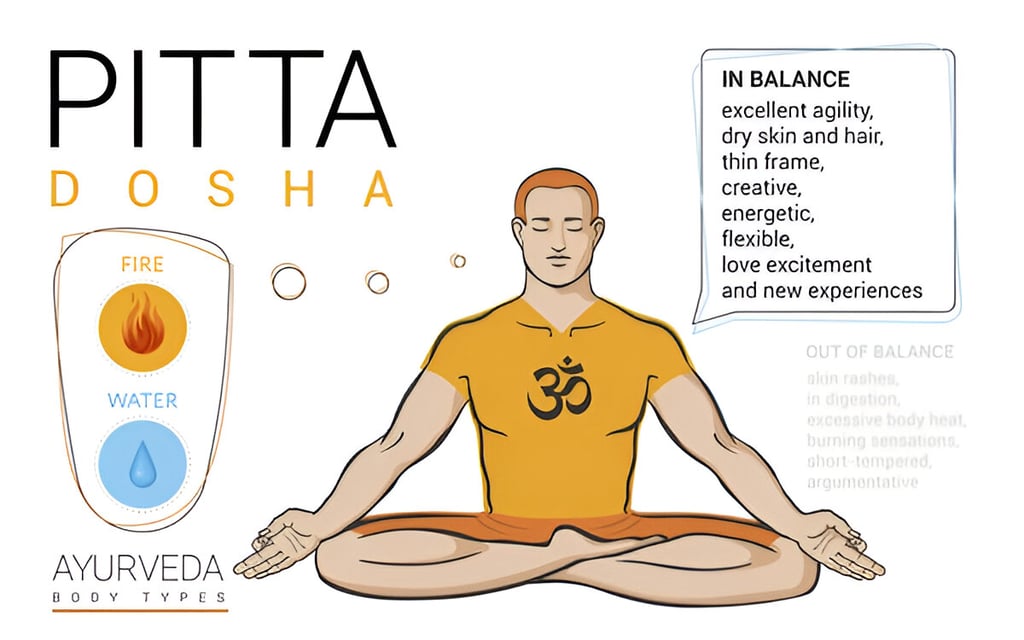Understanding Pitta Dosha: The Five Pitta Subtypes and Ayurvedic Care at Indus Veda


In Ayurveda, Pitta Dosha—the dynamic fire and water principle—governs digestion, metabolism, body temperature, vision, complexion, and emotional regulation. When Pitta is balanced, it brings mental clarity, efficient digestion, and a glowing appearance. But when aggravated, Pitta leads to inflammation, acidity, ulcers, skin disorders, and emotional irritability.
At Indus Veda Super Speciality Ayurvedic Hospital, we specialize in identifying and treating the root causes of such imbalances through authentic and personalized Ayurvedic care.
🔥 The Five Subtypes of Pitta Dosha
Pitta is further divided into five subtypes, each managing a distinct physiological function:
1. Pachaka Pitta (Located in: Stomach & Small Intestine)
Function: Governs digestion and nutrient assimilation.
Imbalance Signs: Acid reflux, indigestion, bloating, or loose stools.
2. Ranjaka Pitta (Located in: Liver & Spleen)
Function: Converts digested food into blood and imparts color to bodily fluids.
Imbalance Signs: Jaundice, liver congestion, yellowing of the skin and eyes.
3. Bhrajaka Pitta (Located in: Skin)
Function: Controls skin health, complexion, and temperature regulation.
Imbalance Signs: Acne, rashes, inflammation, or burning sensations on the skin.
4. Alochaka Pitta (Located in: Eyes)
Function: Manages eyesight and visual perception.
Imbalance Signs: Eye irritation, redness, sensitivity to light, blurred vision.
5. Sadhaka Pitta (Located in: Heart & Mind)
Function: Regulates emotions, intelligence, memory, and motivation.
Imbalance Signs: Irritability, anxiety, overthinking, insomnia.
By understanding which subtype of Pitta is disturbed, Ayurvedic practitioners can create highly customized treatments.
🚨 Common Signs & Diseases of Pitta Imbalance
When Pitta becomes excessive, it shows up in both the body and mind:
Physical Signs:
Burning sensation in stomach
Acid reflux and ulcers
Hot flashes and excessive sweating
Skin inflammation, acne, rashes
Yellowing of the skin/eyes
Strong body odor
Emotional Signs:
Anger, frustration, impatience
Jealousy, competitiveness
Burnout, insomnia, emotional rigidity
Chronic Conditions Linked to Prolonged Pitta Imbalance:
Ulcerative colitis, IBD
Gallbladder stones
Hyperthyroidism
Hypertension
Psoriasis, eczema
Liver disorders
Example: A patient with constant acidity, acne, and mood irritability may have imbalances in Pachaka, Bhrajaka, and Sadhaka Pitta.
🌿 How Ayurveda Balances Pitta Naturally
Ayurveda focuses on restoring harmony through food, routine, herbs, and detox therapies tailored to Pitta's nature.
🥗 Diet:
Favor cooling foods like milk, ghee, cucumbers, melons, coconut water, and leafy greens.
Eat sweet, bitter, and astringent tastes.
Avoid spicy, sour, salty and fermented items.
Drink herbal teas like mint, coriander, fennel.
🧘 Lifestyle:
Avoid excessive sun, heat, and late nights.
Engage in gentle activities like yoga, swimming, walking.
Practice deep breathing, meditation, and relaxation techniques.
Maintain a regular sleep routine.
🌿 Herbs & Formulations:
Herbs like amla, brahmi, neem, turmeric, licorice, sandalwood help reduce excess Pitta.
Classical preparations like Avipattikar Churna are used for hyperacidity, under expert supervision.
💆 Panchakarma Therapies:
Virechana (therapeutic purgation) is the key detox for Pitta.
Abhyanga with cooling oils (e.g., coconut, sandalwood oil).
Swedana (herbal steam) to reduce inflammation.
Shirodhara and Marma therapy to calm Sadhaka Pitta and soothe the nervous system.
🏥 How Indus Veda Ayurvedic Hospital Helps Restore Pitta Balance
At Indus Veda, our expert Ayurvedic doctors provide root-cause treatment, not just symptom relief. We start with a thorough consultation using Nadi Pariksha (pulse diagnosis), tongue, and eye analysis to determine which Pitta subtype is aggravated.
Based on the diagnosis, we create a customized treatment plan that may include:
Personalized diet and lifestyle changes
Herbal formulations tailored to specific imbalances
Full-spectrum Panchakarma therapies
Yoga, meditation, stress counseling
Regular follow-ups and monitoring
For instance:
A Pachaka Pitta case (acidity, loose stools) may receive digestive herbs, Virechana, and gut-soothing teas.
A Bhrajaka Pitta case (skin rash, acne) may involve herbal pastes, oil massages, and internal cooling herbs.
A Sadhaka Pitta case (emotional burnout) may include Shirodhara, Brahmi formulations, and guided meditation.
We ensure all treatments are doctor-supervised, safe, and suited to your body type and condition.
📊 Quick Reference Table
Pitta Subtype Function Imbalance Signs Pachaka Pitta Digestion, metabolism Acidity, heartburn, loose stools Ranjaka Pitta Liver function, blood formation Jaundice, liver congestion Bhrajaka Pitta Skin health Acne, rashes, redness Alochaka Pitta Visual processing Eye strain, redness, poor night vision Sadhaka Pitta Emotions, memory, mental clarity Anxiety, irritability, mood swings
🧭 Your Journey to Balance Starts Here
If you're dealing with chronic inflammation, digestive distress, skin issues, or mental burnout, it may be time to check for Pitta imbalance. Ayurveda offers a natural, time-tested path to restore equilibrium.
At Indus Veda Ayurvedic Hospital, our goal is not just temporary relief—but complete healing by rebalancing your doshas through expert care, authentic treatments, and holistic wellness.
✅ Book your personalized consultation today and experience the power of Ayurveda tailored to your unique body and mind.

